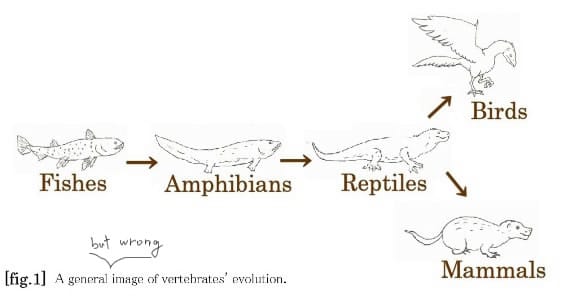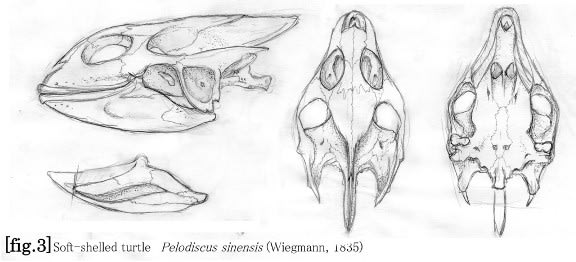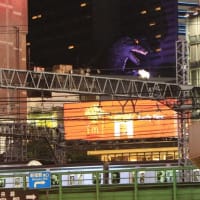
When you talk about reptiles, what kind of the feature do you imagine? They have dry skin covered by scales, breath through lungs, be cold blood, and their egg have hard shell. And also you might say, “They are primitive.”
In general, the word “evolution” tends to be interpreted wrong meaning; evolution is a synonym of the word “progress”. So they thinks that if apes became human beings, we should be higher than them. In reality, evolution is a changing phenomenon over time, and it does not mean progress. Further more, the expression “human beings were born from apes like chimpanzee” is not correct; it is exact that human beings and chimpanzee were evolved from common descent.
Against the truth written above, many Japanese students believe lizards or crocodiles are old type animals. We sometimes see general vertebrates’ evolutional story, fish evolves amphibians, and next they became reptiles, and result birds and mammals. [fig.1] Of course, It is important image to teach animal history for children. But at least for high school students who study biology, we should tell more detail of evolution, shouldn’t we?
Reptile, mammal, or bird, etc. are named from current animals. Ancient age’s “reptile” features are not equal to todays. (For example, dinosaurs and their related species must be warm-blooded.) Mammals and birds are not evolved from lizards, crocodiles, or turtles. Similar to mammals and birds, current reptiles evolved from ancient animals. Ancient reptile group have had a great amount of species (almost all of them were extinct). Today’s reptiles are rather new group. Perhaps, the day of mammal became mammal might be older the day of lizards. Look at [fig.2] and you’ll see what I try to tell you immediately.
Amniota means “the animals that have a membrane (called amnion) in embryonic age to bear waterless environment and adapt to life on land.” Amniota firstly divergence Synapsida and Reptilia. Reptilia is synonym of Sauropsida, means “lizard like face.” Like this, classification of vertebrates is depending on their cranial skeletons at first. Anapsida and Diapsida in fig.2 are also important group categorized by their head skeletons’ features.
All current reptiles are belong to Reptilia. You’ll find familiar names on the down-right side of the tree. They are not only one group. Lizards and snakes are Lepidosauria. And tuatara(today, this group has only one specie living in New Zealand) belongs to Sphenodontia. These groups put together in Lepidosauromorpha; some study argues that Ichtyosauria and Sauropterygia belong into this group.
Archosauromorpha is much same various group as Lepidosauromorpha. There are so many small groups in Archosauromorpha. Archosauria is one of them (not shown in fig.2). This group includes crocodiles and dinosaurs. You may know about the evolutional relationship between dinosaurs and birds, soon you recognize the phylogenic truth; all birds belongs to the same group as crocodiles. Phylogenic tree tells us that every birds are in only small sprig of the huge Reptilia’s tree trunk. Moreover, the lineage is not from “reptiles”, but stand in a line with lizards’ and snakes’ group. We cannot get this knowledge when we only to see an image like fig.1.
Synapsida is an enormous group. Though I omit the detail of the group in fig.1, you’ll soon find the name mammal in Pelycosauria and expect it is a small group like birds. (But some researcher say that Mammalia is not so small and it should stand in line with Pelycosauria and Therapsida.) You may also have a question at this point. Not-mammal Synapsids are reptiles or not? What are them? To tell the truth, some of them bear babies but the others eggs, some skins covered by scales but the others are fur. But although they include many exceptions, most of them may have scales, lungs, cold blood, and egg with hard shell. One time, we called this group “mammal-like reptiles”. But, as written above, “reptile” is named from today’s animal feature. Fig.2 lineage show that we could not use the same name “reptile” in the Synapsida. So, though most of not-mammal Synapsids might have resemble feature, they cannot be called reptile in these days. According to this logic, story of reptiles became mammals like fig.1 is have to be corrected. There will be many influences to everywhere.
In fig.2, there are two linage linked by question mark. These are Testudines(turtle, tortoises, etc.) group[Fig.3]. Old days, every scientist thought turtles are belonging to Anapsida from fossil record. But recently, some scientists argue that their cranial skeletal features are so specialized but many other characters induce us to say they are Diapsida. And more, quite recently, molecular analyzes produced a interesting answer, turtles are Archosauria; same group of crocodiles and dinosaurs. Today, this argument are not came to end. More and more papers are published, and scientists discussion each other.
Reptiles like turtles are familier animal, but in the truth, we have so little knowledge about them. They are so great in number, and great specialized animals. We need to remove the prejudice that they are old and primitive. □
References:
・『Five Kingdoms』 Lynn Margulis & Karlene V. Schwartz :Author W.H.Freeman & Co Ltd; 2Rev Ed edition (October 1987)
・『Memoirs of Osaka Kyoiku University
Ser.IV Education, Psychology, Special Education and Physical Education Vol.51 No.2 (Feb. 2007)』
・『恐竜学 進化と絶滅の謎』 David E.Fastovsky ・David B.Weishampel :著, John Sibbick :イラスト, 真鍋 真:翻訳 丸善 (Jul. 2006)
・『チャート式 新生物IB・II』 小林弘:著 数研出版 (1995年)
・『バイオディバーシティー・シリーズ7 脊椎動物の多様性と系統』 岩槻邦男・馬渡俊輔:監修 松井正文:編集 裳華房 (2006年)
All figures are drawn by LOKI:.
生物好きな中高生向けを想定して、ちょっとナショジオっぽく、あまり文法とか気にせずザクザク書いてみた。
要は、"魚類→両生類→爬虫類→哺乳類や鳥類"ってのは、本当は正しくはないぜっていう話。
"魚類・両生類・爬虫類・哺乳類・鳥類"は並列に置けるグループ分けじゃないんだよ、
というのを、有羊膜類(amniota; いわゆる爬虫類・鳥類・哺乳類)で一般向けに説明してみようと考えて書きました。
つまり私の一番好きなトコロね。
本当はサカナとかも含めて説明したいけれど、それはあまりにも壮大で複雑になってしまうので、
一般向けに英語で書こうと試みるのはなかなか…
読聞ヨリモ書喋ガハルカニ難シ。
なかなか上手く書けんなぁ。
練習練習。
何か指摘あったらよろしくお願いします。
BLOG内記事LINK=
・evolution: 生物進化の論理.
・chordata: 脊索動物門について.
・suppon -skeleton-: fig.3で示したスッポンの骨格に関して.
・neural crest cells: 脊椎動物の頭部骨格形成,その系統進化に深く係る,神経堤細胞.
・dino=phylogenetics:1 恐竜類を中心とした,爬虫類の系統関係について.
・development =gallus: ニワトリの発生.
< βλογ πετ >![]()
![]()



















